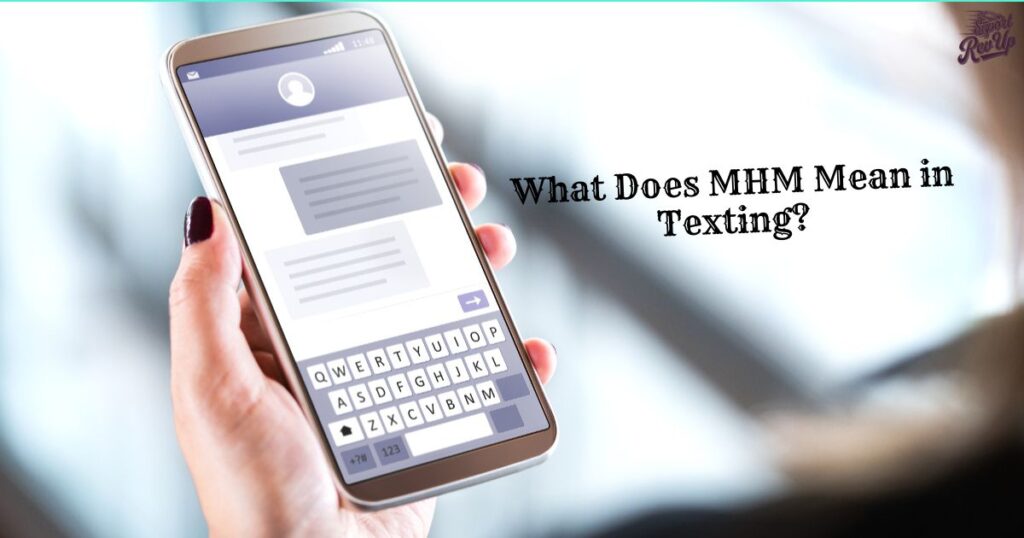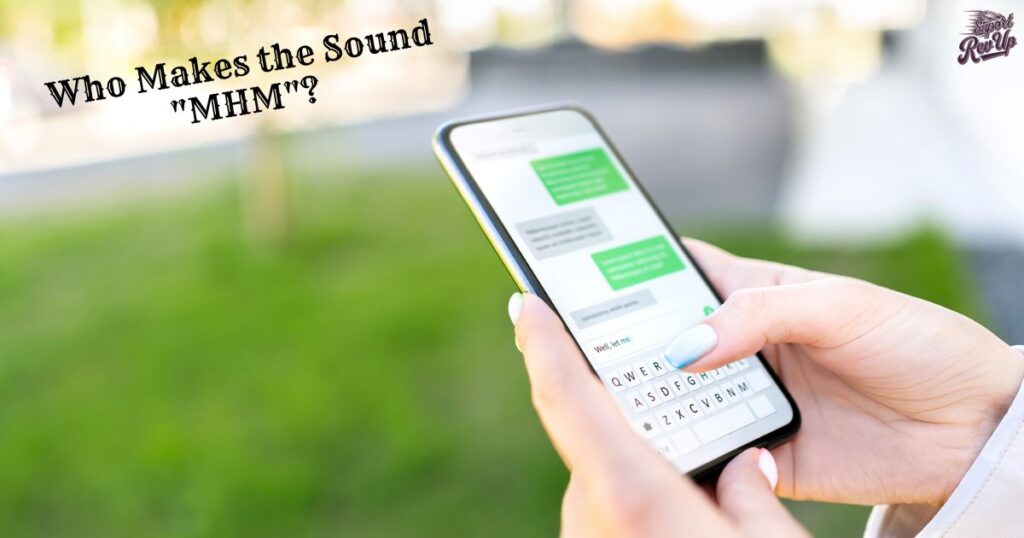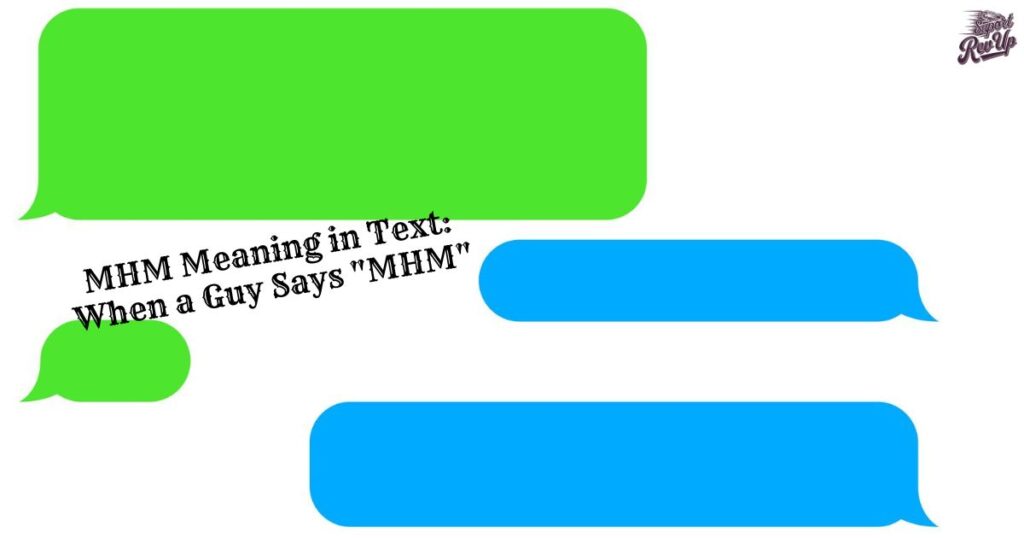In the fast-paced world of digital communication, text messages have become our go-to method for staying connected.
But with this convenience comes a whole new language of abbreviations, slang terms, and nonverbal cues that can sometimes leave us scratching our heads.
One such enigmatic expression that’s taken the internet by storm is “mhm.” So, what does “mhm” mean in text messages, and how can you use it effectively in your online conversations?
“MHM” Meaning: The Basics
At its core, “mhm” is the text equivalent of the verbal “mm-hmm” – a casual, often noncommittal way of saying “yes” or showing agreement.
It’s a prime example of how spoken language evolves in the digital world, transforming nonverbal cues into written form.
In the realm of text messages and social media platforms, “mhm” serves as a quick acknowledgment, a virtual nod that keeps the conversation flowing without interrupting its rhythm.
The beauty of “mhm” lies in its versatility. It can convey a range of emotions and intentions, from enthusiastic agreement to reluctant acceptance, depending on the context and how it’s used.
This slang term has become a staple in casual, abbreviated communication, particularly among younger generations who prize efficiency in their digital interactions.
What Does MHM Mean in Texting?

When it comes to texting, “mhm” is more than just a simple “yes.” It’s a nuanced expression that can carry various shades of meaning depending on the situation. Here’s a deeper dive into its usage:
- Affirmation: In its most straightforward use, “mhm” is a quick way to say “yes” or “I agree” without typing out the full words. It’s perfect for those rapid-fire text exchanges where every second counts.
- Acknowledgment: Sometimes, “mhm” simply means “I hear you” or “I’m listening.” It’s a way to show that you’re engaged in the conversation without necessarily agreeing or disagreeing with what’s being said.
- Noncommittal response: In certain contexts, “mhm” can be used to give a vague or noncommittal answer. It’s the digital equivalent of a shrug, useful when you’re not quite sure how to respond or don’t want to commit to a definitive answer.
- Sarcasm or disbelief: Like many slang terms, “mhm” can be used sarcastically. A well-placed “mhm” can convey skepticism or disbelief, especially when paired with an eye-roll emoji.
Understanding these nuances is crucial for effective communication in the digital age. The meaning of “mhm” can shift dramatically based on the relationship between the texters, the topic at hand, and even the punctuation used (or not used) alongside it.
What Does MHM Mean on Snapchat?
On platforms like Snapchat, where brevity and visual communication reign supreme, “mhm” takes on an even more casual tone.
Snapchat users often incorporate “mhm” into their stories, captions, and direct messages as a quick way to engage with content or respond to friends.
In the Snapchat ecosystem, “mhm” might be paired with Bitmojis or stickers to add an extra layer of meaning.
For instance, an “mhm” with a smirking Bitmoji could indicate playful agreement, while an “mhm” with a sleepy-faced Bitmoji might suggest bored acknowledgment.
The youth-oriented culture of Snapchat has also led to creative variations of “mhm,” such as “mhmm” or “mmhmm,” which can add emphasis or personality to the basic expression.
These variations showcase how language evolves on social media platforms, with users constantly finding new ways to express themselves within the constraints of text-based communication.
How to Use MHM: A Step-by-Step Guide
Mastering the art of “mhm” can elevate your texting game. Here’s how to use it effectively:
- Assess the situation: Is a quick acknowledgment appropriate, or does the conversation call for a more thoughtful response?
- Consider your relationship with the texter: “Mhm” might be perfect for a close friend but too casual for a professional contact.
- Think about tone: A simple “mhm” can be neutral, but adding punctuation (like “mhm!”) can change its meaning entirely.
- Use emojis wisely: Pairing “mhm” with an emoji can clarify your intention and add emotional context.
- Don’t overuse it: Like any slang term, “mhm” loses its impact if used too frequently.
Remember, the key to using “mhm” effectively is understanding its place in the broader context of digital communication. It’s a tool in your texting toolkit, not a one-size-fits-all response.
Alternative Meanings of MHM
While “mhm” primarily serves as an affirmative response, it’s worth noting that like many internet acronyms and slang terms, it can have alternative meanings in different contexts.
In some niche online communities or regional texting cultures, “mhm” might stand for something entirely different.
Always be aware of the potential for misunderstandings, especially when communicating across different age groups or cultural backgrounds.
- More Post: Love Is Blind Season 6: A Deep Dive into Filming Locations, Couples, and Behind-the-Scenes Magic
Understanding “MHM’s” Origin
The journey of “mhm” from spoken language to texting slang is a fascinating example of linguistic evolution in the digital age.
The sound “mm-hmm” has long been used in verbal communication as a way to show agreement or acknowledgment without interrupting the speaker.
As text messaging became more prevalent, users sought ways to replicate these nonverbal cues in written form.
The transition of “mhm” to text speak also reflects broader trends in how we communicate online.
In a world where brevity is prized and typing speed can make or break a conversation, abbreviated forms like “mhm” allow us to maintain the flow of dialogue while minimizing effort.
Additional Meanings and Nuances
The world of “mhm” is richer than it might first appear. Subtle variations in spelling, such as “mhmm” or “mmhm,” can convey different levels of enthusiasm or agreement.
Capitalization also plays a role – “MHM” might indicate stronger agreement or even exasperation compared to the lowercase “mhm.“
Moreover, “mhm” can serve as a conversation filler, much like “um” or “uh” in spoken language. It’s a way to maintain engagement in a text conversation when you don’t have much to add but want to show you’re still present and listening.
Who Makes the Sound “MHM”?

While “mhm” is used across various demographics, its usage patterns can differ. Younger generations, particularly those who grew up with texting as a primary form of communication, tend to use “mhm” more frequently and casually.
In professional contexts, “mhm” might be seen as too informal, with more traditional affirmatives like “yes” or “I see” being preferred.
Understanding these demographic differences can help you tailor your use of “mhm” to your audience, ensuring your digital communication is both effective and appropriate.
MHM Meaning in Text: When a Guy Says “MHM”

When a guy uses “mhm” in a text, it can carry various meanings depending on the context and relationship dynamics.
In general, men might use “mhm” as a quick way to show they’re listening without diving deep into a conversation. It could indicate anything from genuine interest to mild disengagement.
In romantic contexts, a guy’s “mhm” might be a way of playing it cool or maintaining some emotional distance. However, it’s crucial not to over-interpret – sometimes, an “mhm” is just an “mhm,” regardless of gender.
MHM Meaning in Text: When a Girl Says “MHM”
Similarly, when a girl uses “mhm” in texting, the meaning can vary widely. It might be used as a soft agreement, a way to keep a conversation going without committing to a strong opinion, or even as a subtle indication of annoyance or disinterest.
In some cases, girls might use “mhm” as a way to prompt more information from the other person, essentially saying, “I’m listening, tell me more.” As with guys, it’s important not to make sweeping generalizations based on gender – individual communication styles vary greatly.
Illustrations of MHM Meaning in Text
To better understand how “mhm” functions in real-world texting scenarios, let’s look at a few examples:
- In a friend group chat discussing weekend plans: Friend A: “How about we go to that new pizza place on Saturday?” Friend B: “Mhm, sounds good!” Here, “mhm” is used as an enthusiastic agreement, reinforced by the exclamation point.
- In a romantic conversation: Person A: “I had a great time last night.” Person B: “Mhm” In this case, the lone “mhm” might be a warning sign, indicating disinterest or reluctance to engage further.
- In a work setting: Colleague A: “Did you get a chance to look over those reports?” Colleague B: “Mhm, I’ll have feedback for you by EOD.” Here, “mhm” serves as a professional acknowledgment, followed by more specific information.
When Should I Use MHM Instead of Just Saying Yes?
“Mhm” shines in situations where a softer affirmation is needed. It’s perfect for maintaining the flow of a conversation without interrupting the other person’s train of thought.
Use “mhm” when you want to show you’re listening and broadly agree, but don’t necessarily want to make a strong statement.
However, in more formal or serious conversations, a clear “yes” might be more appropriate. “Mhm” carries a casual, laid-back tone that might not fit all situations.
When Should I Apply “MHM”?
Ideal scenarios for using “mhm” include:
- Casual conversations with friends
- Showing you’re following along in a story or explanation
- Providing quick acknowledgment in a fast-paced text exchange
Avoid using “mhm” in formal business communications, when responding to important questions, or in situations where your level of engagement or agreement needs to be crystal clear.
The Future of “MHM” in Digital Communication
As our online interactions continue to evolve, so too will expressions like “mhm.” We might see new variations emerge, or perhaps “mhm” will be largely replaced by emojis or reactions.
Whatever the future holds, understanding the nuances of digital communication will remain crucial for effective interaction in the online world.
Conclusion
In the vast landscape of internet slang and texting abbreviations, “mhm” stands out as a versatile and nuanced expression. Its meaning can range from enthusiastic agreement to noncommittal acknowledgment, depending on context, relationship, and usage. By understanding the various shades of meaning behind “mhm,” you can navigate text conversations with greater ease and clarity.
Remember, effective communication in the digital age isn’t just about knowing what abbreviations mean – it’s about understanding how to use them appropriately. So the next time you’re tempted to drop an “mhm” in your text message or social media post, take a moment to consider its potential interpretations. Used wisely, “mhm” can be a powerful tool in your digital communication arsenal.
FAQs
What does MHM mean in a text message?
“Mhm” in a text message typically means “yes” or “I agree.” It’s a casual way to show acknowledgment or agreement, similar to saying “uh-huh” or “mm-hmm” in spoken conversation. It can also indicate that you’re listening or following along in a chat.
Is saying MHM flirting?
Not necessarily. “Mhm” isn’t inherently flirtatious. It’s usually just a neutral acknowledgment. However, like any word, it could be part of flirting depending on the context, tone, and overall conversation. If it’s paired with flirty emojis or used in response to compliments, it might have a flirtatious tone.
What does MHM mean by a boy?
When a boy uses “mhm” in texts, it typically means the same as when anyone else uses it – a casual “yes” or “I’m listening.” It’s not gender-specific. However, some might use it to seem less eager or to maintain emotional distance. The exact meaning depends on the context and the individual’s texting style.
What is the full form of MHM?
MHM doesn’t have a traditional “full form.” It’s not an acronym where each letter stands for a word. Instead, it’s a written representation of the sound “mm-hmm” that people make to show agreement or acknowledgment in verbal conversation. It’s simply a way to convey this sound in text form.

